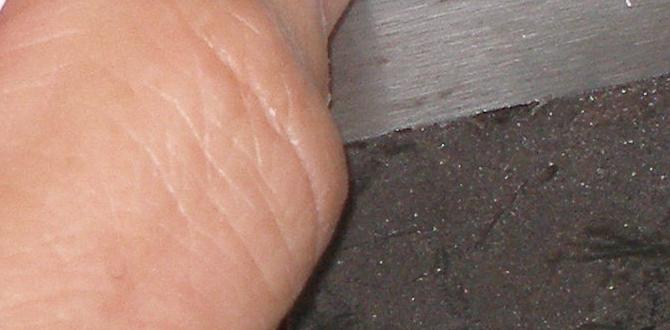A 1/8-inch carbide end mill with a 10mm shank, specifically designed for PMMA (acrylic), is an excellent choice for achieving clean, precise cuts. Its heat-resistant properties prevent melting and sticking, giving you smooth finishes and efficient material removal for your PMMA projects.
Working with PMMA, often called acrylic, can be a bit tricky. You want those clean cuts and smooth edges that make your projects shine, but sometimes it feels like everything just melts or chips. It’s a common frustration for hobbyists and beginners stepping into the world of milling. Don’t worry, though! Getting a perfect finish on PMMA is totally within reach, and a big part of that is choosing the right tool. Today, we’re diving deep into a specific hero: the 1/8-inch carbide end mill, especially those made for materials like PMMA. We’ll explore why this particular tool is your secret weapon, how to use it effectively, and all the tips to ensure your milling projects turn out beautifully. Get ready to banish those messy cuts and start creating with confidence!
Why a 1/8-Inch Carbide End Mill is Your PMMA Best Friend
When you’re milling PMMA, the right cutting tool makes all the difference. It’s not just about having an end mill; it’s about having the right end mill. For PMMA, a 1/8-inch solid carbide end mill, particularly one engineered for plastics and designed to handle heat, is often the gold standard. Let’s break down why.
The Marvels of Carbide
Carbide, also known as tungsten carbide, is a super hard material. It’s much harder than high-speed steel (HSS), which is commonly used for other types of cutting tools. This hardness offers several key advantages when milling PMMA:
Durability: Carbide tools resist wear and tear much better than HSS. This means fewer tool changes and a more consistent cutting performance over time.
Heat Resistance: PMMA can melt easily when friction builds up during cutting. Carbide can withstand higher temperatures before it starts to soften or lose its edge. This is crucial for preventing that gummy, melted mess that plagues PMMA milling.
Sharpness: Carbide can be ground to a very acute cutting edge, which allows it to slice through materials cleanly.
Rigidity: The hardness of carbide also makes it very rigid, which helps reduce chatter and vibration. This leads to smoother finishes and more accurate cuts.
The Power of a 1/8-Inch Diameter
The size of the end mill matters. For many PMMA projects, especially those involving detailed work or thinner sheets, a 1/8-inch diameter is incredibly versatile.
Detail Work: A smaller diameter allows you to create fine details, intricate patterns, and sharp corners that larger tools simply can’t achieve.
Material Removal Rate (MRR): While not as fast as larger end mills for bulk removal, a 1/8-inch end mill offers a good balance. It can efficiently remove material without causing excessive stress on your workpiece or machine.
Shallow Cuts: It’s perfect for making shallow passes, which is often recommended for plastics to manage heat buildup.
The Specialty of PMMA-Specific End Mills
Beyond being carbide and the right size, some end mills are specifically designed for plastics like PMMA. You’ll often see these advertised as “plastic cutting” or “PMMA” end mills, and they typically have specific features:
High Positive Rake Angles: This means the cutting edge is angled forward, helping to “scoop” material away cleanly and reduce the friction and heat generated. Think of it like a sharp knife slicing through something versus a dull one pushing through.
Polished Flutes: The flutes (the spiral grooves) are polished to a mirror finish. This smooth surface allows the chips of plastic to escape easily, preventing them from sticking to the flutes and building up heat or causing a poor finish.
Specific Helix Angles: The angle of the flutes also plays a role in chip evacuation and cutting action. Optimized helix angles help to clear chips effectively.
Heat-Resistant Coatings: Some high-performance end mills may also have specialized coatings designed to further reduce friction and dissipate heat.
The 10mm Shank Advantage
You mentioned a 10mm shank. This is a common shank size, especially for end mills that might be used in a variety of milling machines, including some import CNCs and manual mills. The shank diameter needs to match your milling machine’s collet or tool holder. A 10mm shank is sturdy and provides good rigidity, which is essential for accurate cutting. It’s important to ensure your collet or tool holder can firmly grip the 10mm shank for best results and safety.
Extra Long Considerations
The “extra long” aspect of the end mill refers to its overall length or flute length. An extra-long end mill can be useful for reaching deeper into a workpiece or for making cuts where the spindle isn’t positioned directly above the work. However, for a 1/8-inch end mill, especially when milling PMMA, you generally want to avoid overly long tools because they can be less rigid and more prone to deflection (bending). If you need to reach deep, it’s best to use slower feed rates and shallower depths of cut to maintain accuracy and prevent chatter or breakage. For most standard PMMA milling tasks, a standard flute length on a 1/8-inch carbide end mill is usually sufficient.
Choosing Your 1/8-Inch Carbide End Mill for PMMA
Not all 1/8-inch carbide end mills are created equal, especially when it comes to PMMA. Here’s what to look for to ensure you get the best performance:
Key Features to Prioritize:
Material: Solid Carbide is your go-to.
Coating: Uncoated is often best for plastics as some coatings can increase friction. However, if you find a specific plastic-cutting mill with a specialized low-friction coating, it might be worth considering.
Flute Design: Look for mills with 2 or 4 flutes.
2 Flutes: These generally offer better chip clearance, which is crucial for preventing heat buildup in plastics. They are often preferred for softer materials like acrylics and plastics.
4 Flutes: Provide a smoother finish but can pack chips more easily. They are usually better for harder metals. For PMMA, 2 flutes are often the best starting point.
Rake Angle: High positive rake angles (often 15-25 degrees or even higher) are ideal for cutting plastics. This helps the tool cut rather than rub.
Flute Finish: Polished or mirror-finish flutes are a significant advantage for PMMA to ensure chips don’t stick.
What to Avoid:
High-Speed Steel (HSS): Too much heat generated will dull and potentially melt HSS quickly.
End Mills with Sharply Ground Edges (for metal): These might chip or snag in plastic.
End Mills with Coatings that Increase Friction: Some coatings are designed for specific metal applications and might not be suitable for plastics.
Example Specifications to Look For:
When browsing tool suppliers, you might see descriptions like:
“1/8 inch 2-Flute Upcut Straight-Web Plastic End Mill”
“Carbide End Mill, 1/8 diameter, 10mm Shank, for Acrylic/Plastic”
“O-Flute (single flute) or 2-Flute Spiral End Mill with High Positive Rake” (O-flutes are excellent for plastics too, for maximum chip evacuation).
Important Note on Shank Size: Always double-check that the shank size (in this case, 10mm) is compatible with your milling machine’s tool holding system (collets, chucks, etc.).
Where to Buy:
Reputable tool suppliers are your best bet. Look for specialized tooling manufacturers or well-known industrial supply companies. Some excellent sources include:
Online Tool Retailers: Companies like McMaster-Carr, MSC Industrial Supply, Grainger, and many specialized CNC tooling websites.
Specialized Plastic Tooling Manufacturers: Brands that focus on tooling for plastics often offer the best solutions.
Setting Up Your Mill for PMMA Success
Before you even touch the end mill to the acrylic, proper machine setup is key. This isn’t just about getting a good cut; it’s about ensuring safety and preventing damage to your material and your tool.
Machine Preparedness:
1. Cleanliness: Ensure your milling machine’s spindle, tool holder, and work area are clean and free of debris.
2. Rigidity: Make sure your workpiece is securely clamped. Any movement or vibration will lead to poor cuts. Use clamps that won’t mar or crack the acrylic. Soft jaw vises or specialized acrylic fixturing can be very helpful.
3. Spindle Speed (RPM): This is critical for plastics. Generally, you want to run PMMA at a higher spindle speed than you would for most metals. This allows the end mill to cut efficiently rather than generating excessive heat through friction. A common starting point for a 1/8-inch end mill on PMMA might be anywhere from 10,000 to 25,000 RPM, depending on the material properties, the specific end mill, and your machine’s capabilities. Always consult your end mill manufacturer’s recommendations if available.
4. Feed Rate: This is how fast the tool moves into the material. For PMMA, you generally want a relatively fast feed rate. This helps the tool to cut cleanly and prevent melting by ensuring each flute takes a small, clean chip. If the feed rate is too slow, the tool will rub and melt the plastic. A good starting point for a 1/8-inch, 2-flute mill might be around 0.002 to 0.006 inches per tooth (IPT). This translates to a feed rate (in inches per minute, IPM) of: Feed Rate (IPM) = RPM × Number of Flutes × IPT.
Example: 15,000 RPM × 2 Flutes × 0.003 IPT = 90 IPM.
Always start conservatively and adjust based on the results.
5. Depth of Cut (DOC): For plastics, it’s best to take shallow depths of cut. This minimizes heat buildup and reduces the risk of chipping or melting. Start with a DOC of around 0.010″ to 0.030″ (0.25mm to 0.75mm) for a 1/8-inch end mill.
Cooling and Chip Evacuation:
PMMA needs help with heat. Even with the right tools, managing temperature is key.
Air Blast: A directed stream of compressed air is often the most effective way to keep PMMA cool and clear chips. The air blast should be directed at the cutting zone to blow chips away and cool the end mill and the material.
Coolant/Lubricant: While sometimes used, traditional liquid coolants can sometimes cause issues with acrylics (like crazing or clouding) or create a mess. If you do use a liquid, a specialized plastic-friendly coolant or even a light mist of water with a bit of soap might be considered, but compressed air is usually preferred for cleanliness and ease of use. Avoid heavy oils.
Interrupted Cuts: If you notice heat building up, it’s sometimes beneficial to program small breaks in your cutting path to allow the material to cool slightly, or to ensure your feed rate/air blast is aggressive enough to clear chips effectively.
Step-by-Step Guide: Milling PMMA with Your 1/8-Inch Carbide End Mill
Let’s get this drill rolling! Here’s a practical, step-by-step guide to milling PMMA using your 1/8-inch carbide end mill.
Step 1: Design and CAM Preparation
Design Your Part: Create your design in CAD software. Ensure your design accounts for the 1/8-inch tool diameter (e.g., inner corners will have a radius equal to half the tool diameter unless you plan to use a profiling strategy that can handle sharp corners with multiple passes).
CAM Toolpath Generation: In your CAM software, set up the milling operation.
Select a 1/8-inch end mill with the appropriate flute count (2 flutes recommended for PMMA) and geometry (e.g., high positive rake, polished flutes).
Define your cutting strategies (e.g., pocketing, profiling, contouring).
Input your spindle speed and feed rate. Start with conservative values and be prepared to adjust.
Set the depth of cut (DOC) to be shallow.
Ensure chip load (implied by feed rate and flute count) is appropriate.
Crucially, ensure good stepover for pockets (25-50% of tool diameter is a good start) and a climb milling strategy for profiling where possible.
Step 2: Machine Setup and Workholding
Load the End Mill: Securely insert the 1/8-inch carbide end mill into your collet or tool holder. Ensure the collet is the correct size (1/8-inch or a close metric equivalent that fits securely) and that the end mill is seated properly.
Secure the PMMA: Clamp your PMMA sheet firmly to the milling table. Use clamps, a vise, or even specialized vacuum fixturing. Ensure the clamps are positioned so they don’t interfere with the toolpath, and that they apply even pressure without cracking the acrylic.
Zero Axes: Home your machine and set your work offsets (X, Y, Z zero points) accurately using your CAM program’s origin point. For Z zero, touch off on the top surface of the PMMA.
Step 3: Initial Cutting Parameters (The First Test Cut!)
Set RPM: Set your spindle to the desired RPM. For PMMA, this is usually on the higher side (e.g., 15,000-25,000 RPM).
Set Feed Rate: Program your feed rate for the first pass. Start conservatively (e.g., 90 IPM like in the example above).
Set Depth of Cut: Ensure your first depth of cut is shallow (e.g., 0.020″).
Engage Air Blast: Turn on your compressed air blast to cool the cutting area and clear chips.
Step 4: Running the First Program (Dry Run Recommended First)
Dry Run (Optional but Recommended): Before cutting material, sometimes it’s wise to run the program with the spindle off (or at a very low RPM safely above the material) to visually confirm the toolpath and clearances.
First Cut: Start the milling program.
Listen to the sound: A good cut should sound like a consistent, light “chirping” or “shaving” sound. A high-pitched squeal might indicate rubbing and heat buildup. A loud chattering or grinding could mean too much material is being taken, or the workpiece/tool is not rigid.
Watch the chips: They should be small, light, and easily ejected. You shouldn’t see wisps of smoke or melting plastic.
Observe the finish: The cut surface should be smooth and glossy, not dull or melted.
Step 5: Adjusting and Fine-Tuning
If Melting Occurs:
Increase feed rate (make it faster).
Decrease depth of cut (take shallower passes).
Ensure your air blast is effective and directed correctly.
Consider a slightly higher RPM if your machine can handle it without introducing excessive vibration.
If Chattering or Rough Finish:
Decrease feed rate slightly.
Decrease depth of cut.
Check workpiece clamping and tool holder security.
Ensure no play in the machine’s axes.
If Tool Seems to Be Struggling:
Ensure you are not taking too aggressive a depth of cut or feed rate for the tool and machine.
Check if the end mill is dull or damaged.
Step 6: Completing the Part
Once you are satisfied with the first pass and the parameters, let the machine run through the entire program, taking multiple shallow passes until the final depth is reached.
Always maintain a focus on chip evacuation and cooling throughout the process.
Troubleshooting Common PMMA Milling Issues
Even with the best setup, you might run into a few common hiccups. Here’s how to tackle them:
Issue: Melting or Gumming Up
Problem: Heat is building up faster than it can be dissipated, causing the PMMA to soften and stick to the end mill.
Solutions:
Increase Feed Rate: This is often the most effective solution. Move the tool faster so it cuts a thin chip rather than rubbing.
Decrease Depth of Cut (DOC): Take shallower passes to reduce the amount of material the tool is engaging at once.
Improve Chip Evacuation: Ensure your air blast is strong and directed right at the cutting edge. Check for any obstructions in your flutes that might be trapping chips.
Increase Spindle Speed (RPM): A higher RPM can mean the tool engages the material more times per revolution, allowing each chip to be smaller and cooler, provided the feed rate is also increased proportionally to maintain chip load.
Check Tool: Make sure your end mill is sharp and not dull. A dull tool generates more heat.
Issue: Chipping or Cracking of the PMMA Edge
Problem: The cutting forces are too high, or the tool is not cutting cleanly, leading to brittle fracture of the plastic.
Solutions:
Reduce Depth






